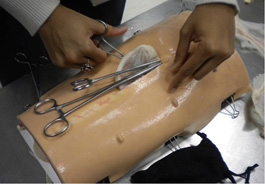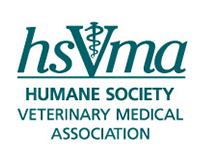Humane Veterinary Education
Uncovering Ethical Alternatives While Studying My Veterinary Student Colleagues
 Head of a dog cadaver used in veterinary education. Sy Woonby Sy Woon
March 25, 2013
During my third year as a veterinary student at the University of Sydney, Australia, I was thrilled at the news I’d been selected to present at the 8th World Congress on Alternatives and Animal Use in the Life Sciences, in Montreal, Canada. The specific session I was invited to participate in was "Innovative Training in Human and Veterinary Medicine," with my focus being a veterinary student’s perspective on harmful animal use in education and humane teaching methods.
This invitation not only gave me the exciting opportunity to travel to Montreal from my homeland of Australia, but also forced me to question our use of animals in medical and veterinary training, and consequently uncover a wealth of knowledge relating to humane veterinary education that I’d been oblivious to. Although I was heavily involved in campaigning for numerous animal welfare issues as president of the university’s Animal Welfare Society, I hadn’t been aware of the welfare concerns behind our own animal use, nor that ethically-superior options existed in other veterinary schools overseas!
Delving Into Cadavers and Ethics
Thus began my research and the discovery that, although my veterinary school was at the forefront of humane veterinary curricula within Australia having eliminated terminal surgeries and invasive physiology practicals, as well as developing non-animal alternatives, I had been unknowingly participating in using cadavers that weren’t regarded as “ethically-sourced” by peer-reviewed standards. Ex-racing greyhounds, pound (shelter) dogs, and abattoir specimens used in the majority of our practical classes are not classified as ethically-sourced, even if, as we are reassured, they were killed independent of our usage. The correct definition of “ethically-sourced” implies the animals obtained have died due to medical reasons, in an accident, or from natural causes, rather than being incidental by-products of unethical industries; the racing industry euthanises thousands of healthy greyhounds deemed unprofitable, and pound dogs are routinely euthanised due to overpopulation.
Beginnings of a Veterinary Student Study
Accordingly, I set about exploring the availability of ethical alternatives and undertook a pilot study of my University of Sydney veterinary student colleagues to gauge their knowledge level regarding humane options and attitudes towards cadaver use. I based my study on Dr Catherine Tiplady’s study exploring University of Queensland veterinary student preferences for cadavers, which determined that students appeared increasingly accepting of the euthanasia of unwanted healthy dogs throughout the degree. She also alluded to desensitisation of students and their potential decline in moral development (Tiplady et al., 2011).
For my study, I conducted interviews with the relevant faculty members and distributed surveys to years one to five of our veterinary degree. I asked students to select their preference for one of the following cadaver options: Donated Dogs (i.e. those who are ethically sourced), Ex-racing Greyhounds, Pound Dogs, or No Preference. I also requested participants explain the reason/s for their selection. Thankfully, I ended up receiving a greater response than I’d anticipated.
Results of Student Cadaver Preferences
From the results I obtained, it was clear that my colleagues shared many of my former views; their responses showed largely uninformed convictions regarding the efficacy and feasibility of using ethically-sourced cadavers. Across all years, the majority of students (>50%) selected “no preference”, with written responses indicating a ready acceptance of any cadaver source so long as the animals weren’t directly killed for our purposes. Cadaver preferences seemed based upon assumed learning efficacy rather than actual pedagogical value. For instance, most claimed that greyhounds had the optimal features for learning due to their uniformity in anatomy, minimal fat, and clarity of body structures. Conversely, published studies have actually demonstrated variation in breed and biological diversity is more valuable for enhancing our learning. Students also failed to consider the rarity of actually treating pet greyhounds in clinical practice, a consideration which would render the use of this breed in anatomy practicals less useful.
Advantages of Ethically-Sourced Cadavers
Most students similarly felt the clinically-healthy status of euthanised greyhounds and pound dogs was a necessary learning attribute, which was not unexpected considering we are taught that in order to recognise the abnormal, you must familiarise yourself with “normal.” However, significant evidence actually demonstrates the greater learning advantages gained from our exposure to pathological specimens and associated clinical histories in our first year of anatomy. These benefits have been documented in veterinary schools such as the Cummings School of Veterinary Medicine at Tufts University (TCSVM), which has been using ethically-sourced cadavers for more than a decade.
 Humane alternatives, such as this ovariohysterectomy model, are more readily-available than students may realize. The University of SydneyAlternatives Promote Welfare
Many who selected non-ethical sources showed an apparent resignation towards the issues of greyhound overbreeding and shelter overpopulation, leading to the general utilitarian response: "These animals are euthanized regardless; they might as well be put to use rather than just discarded." Respondents considered these welfare problems irresolvable, thereby justifying their non-ethical preferences. Yet, successful campaigns such as the Animal Welfare League of Queensland’s Getting to Zero [Euthanasia] Model, demonstrate the potential for solving unnecessarily high euthanasia rates in pounds. Similarly, the introduction of a cadaver donation program at TCSVM resulted in the replacement of greyhound killing with a greyhound adoption program.
Veterinary Student Desensitisation and Ethical Concerns
Student responses from those preferring "ex-racing greyhounds" further indicated a conscious desensitisation to this customary cadaver source, describing the ability to disconnect from this seemingly expendable commodity. There seemed to be a level of indifference towards greyhound cadavers, which could also result in a less compassionate regard for this breed. In comparison, the idea that veterinary students even dissect surplus greyhounds causes abject outrage amongst the ex-racing greyhound-owning community due to the gentle nature of this exploited breed.
A number of respondents who preferred "donated dogs" described feeling a moral conflict with supporting the euthanasia of healthy dogs. However, the emphasis upon this compulsory aspect of the course and lack of equivalent alternatives offered may make students reluctant to declare their concerns to avoid being ostracised, deemed incompetent, or offending staff. This may have negative effects upon the psychological well-being of students and their learning capacity, and desensitisation may ensue to assist in coping. Sadly, dedicated students might even be discouraged from continuing due to being unaware of their right to request alternatives under the Faculty of Veterinary Science's Conscious Objection policy.
It is apparent the desensitisation veterinary students undergo to cope with the mandates of the degree toughens us to a variety of unpleasant stimuli. For example, it is not uncommon to witness or hear of students using dissection specimens in distasteful yet glorified practical jokes; a mere example of our resistance to the usual sensitivity and repulsion elicited by these unpleasant stimuli. Of course, such disrespectful behaviour can have adverse repercussions. Anecdotal reports from the UK described unprofessional behaviour by veterinarians towards animal patients that resulted in complaints by co-workers and deregistration by licensing boards. This case simply demonstrates how socially-unacceptable behaviour, resulting from desensitisation, may potentially continue into practice.
Body Donation Programs Demonstrate Success
While the University of Sydney utilises ethically-sourced cadavers solely for pathology practicals, it is apparent the introduction of a dedicated cadaver/body donation program can provide numerous benefits. Veterinary schools claim that students show greater reverence for donated specimens that come with medical histories and are regarded as once-owned pets. The successes of such programs have been documented in several veterinary colleges in the U.S., which continue to effectively supply cadaver needs for anatomy practicals.
Presenting My Results
Having completed my survey and investigation, I presented my findings in Montreal and had an incredible experience while there. I learned more about organisations such as the Medical Advances Without Animals Trust and InterNICHE which provide/promote alternatives, the ethical options offered by veterinary schools worldwide, and the admirable efforts by other veterinary schools to eliminate inhumane practices such as terminal surgeries. A highlight was meeting Dr. Andrew Knight, without whose generous guidance, support and advice I could not have pursued my study (read more information and peer-reviewed papers on humane veterinary education compiled by Dr. Knight). My paper further detailing my study was accepted for publication in ALTEX, a journal devoted to the publication of research on the development and promotion of alternatives to animal experiments (click here to read the paper).
Necessity for Increased Awareness and Support of Ethical Alternatives
From my study, I concluded that students, as well as the academics who inform our curriculum, required a greater awareness of the efficacy and availability of alternatives in order for them to be feasibly accepted. Introducing humane alternatives is not only educationally beneficial, but could help to prevent ethically-conscious students being deterred from veterinary medicine as well as addressing the desensitisation issue. While veterinary students obviously relish our opportunities to "use" animals, this unique privilege does need to be balanced with a conscious pursuit for the most ethical and efficacious means for learning.
Sy Woon is a veterinary student at the University of Sydney Faculty of Veterinary Science (class of 2014), who has served as president of the University of Sydney Animal Welfare Society for the past three years, She is the Student Coordinator for Sentient, The Veterinary Institute for Animal Ethics, as well as founder and former president of the Sydney University Vets Beyond Borders Student Chapter. Her greatest passion lies in advocating for the welfare and rights of all animals through education. After graduating, she hopes to engage in work that involves fostering compassion and a love of animals in children.
|


